Aquariums serve essential functions, and not just for aquarists. Sitting back and watching colorful fish dart around a tank lowers a person’s stress level!
There’s also evidence that quality time viewing an aquarium drops heart rate and blood pressure.
The more colorful the aquarium, the better. Most people think you can only achieve those vibrant hues with saltwater tanks.
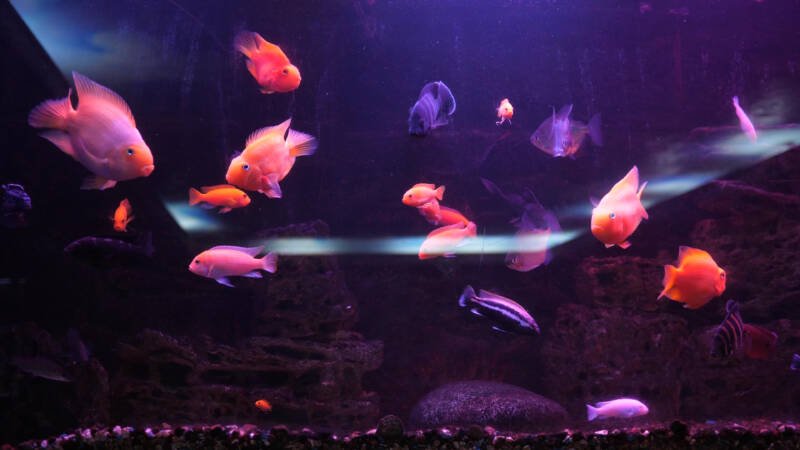
But marine set-ups are expensive, and the maintenance is often complicated. Those brilliant colors and reef fish don’t come cheap, either.
People forget the abundance of colorful freshwater fish available. Well, not everyone: over 11 million households keep freshwater aquariums across America. Freshwater fish join in with cats and dogs as favored pets.
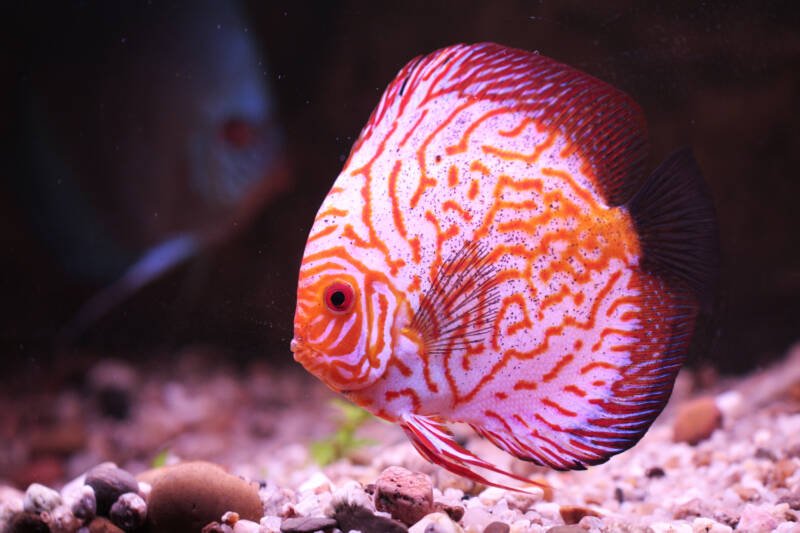
In this article
Colorful Freshwater Fish
This list is the TINIEST fraction of the fish available.
Whether you have your sights on a grand, sweeping aquarium that takes up an entire wall (prepare for some high expenses), or you’re interested in a nano aquarium for your desk, you can find the perfect colorful occupants.
1. Pearl Gourami (Trichopodus leerii)

- Difficulty: Easy
- Temperament: Peaceful
- Diet: Omnivore
- Tank Size: 30 gal (114 l)
The pearl gourami is a labyrinth fish with a specialized organ for directly breathing air. In nature, this allows them to surface and get oxygen in their typically deficient environments.
As such, these fish favor the top portion of the tank, and access to the water surface is a must. Pair them with other peaceful fish that occupy the lower levels.
These hardy fish are relatively undemanding in their water requirements.
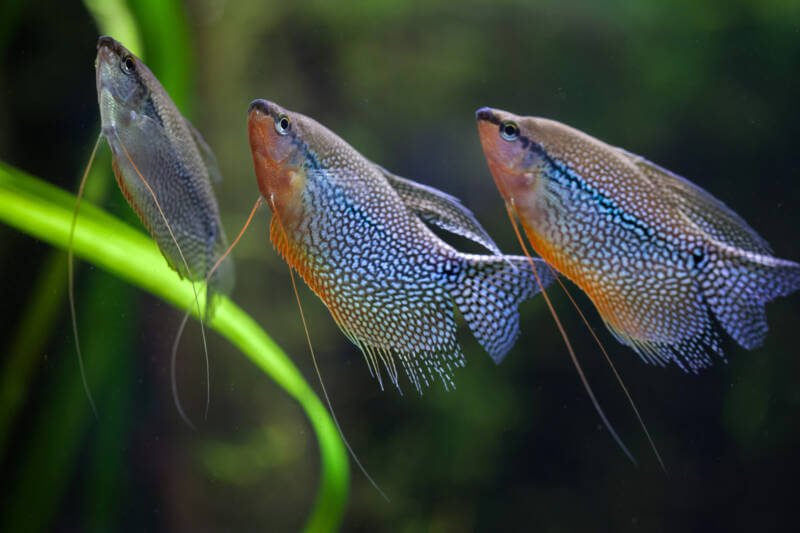
The body, fins, and tail of this fish are covered with pearlescent white dots, thereby lending the name. They have long, wispy ventral fins that extend backward almost to their tail.
Pearl gouramis reach between four to five inches (10 to 13 cm) in length as adults.
2. Red Parrot Cichlid (hybrid)

- Difficulty: Moderate
- Temperament: Peaceful
- Diet: Omnivore
- Tank Size: 40 gal (150 l)
The red parrot is a hybrid fish bred from the combination of a male Midas cichlid and a female redhead.
Peaceful and with an inquisitive nature, the red parrot cichlid is perfect for a community tank. They are somewhat shy and benefit from cave structures and dither fish in their environment.
Avoid placing females with fish such as the convict cichlid to prevent unwanted hybridization. Males of the species are usually infertile.
Males grow to seven or eight inches (18 to 20 cm) in length, while females are closer to six or seven (15 to 18 cm).
These colorful fish start out darker and striped as juveniles. As they grow, their color shifts to the lovely red.
3. Apistogrammas (genus)

- Difficulty: Moderate
- Temperament: Semi-aggressive
- Diet: Omnivore
- Tank Size: 20 gal (76 l)
With over 90 species available, this “dwarf cichlid” has colors and patterns to suit every preference.
Depending on the species, their adult size can range from as small as 0.8 inches to as big as 3.1 (2-8 cm), which is fantastic if you want a small tank!
These fish are prized not only for their somewhat mild temperament (and for a cichlid, that is saying something!) but also for their playful and inquisitive nature.
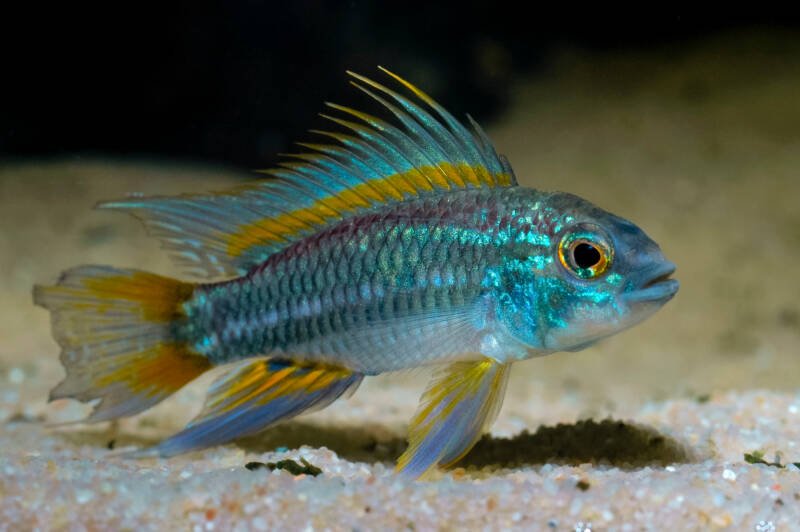
They can be territorial and need a place to claim as their own.
They are highly sensitive to changes in the water temperature and pH and are best for aquarists with some experience. Make sure to add plenty of live plants for these species.
4. Jewel Cichlid (Hemichromis bimaculatus)
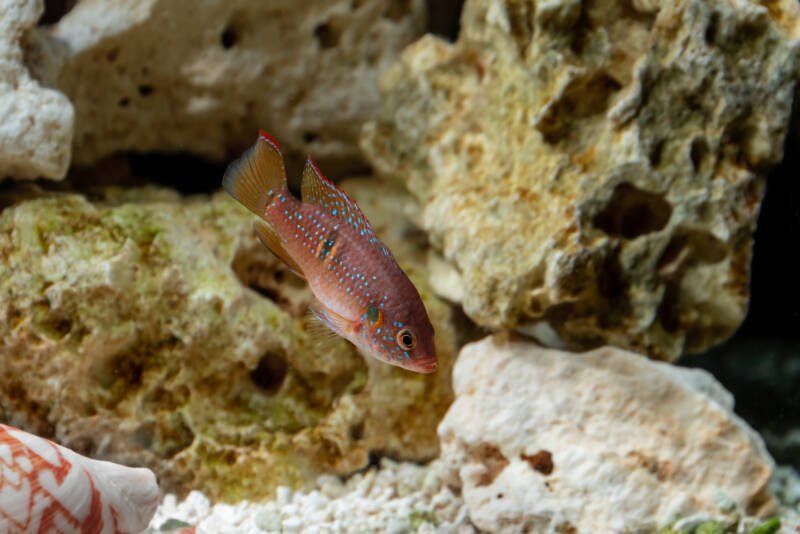
- Difficulty: Difficult
- Temperament: Aggressive
- Diet: Omnivore
- Tank Size: 40 gal (151 l)
There are around 13 species of jewel cichlid, with the most common one sporting a lovely orange-red color covered with brilliant blue-green dots.
They stay close to six inches (15 cm) in length as adults, although in the wild, they can grow to almost a foot!
The biggest challenge in keeping a jewel cichlid is managing their aggression. However, you can mitigate these tendencies with an appropriately sized tank, stable water conditions, and a proper diet.
Highly territorial, these fish are best kept with others jewel cichlids in a tank with decorations and plants to break up the line of sight.
A carefully planned community tank with other African cichlids is possible.
5. German Ram (Mikrogeophagus ramirezi)
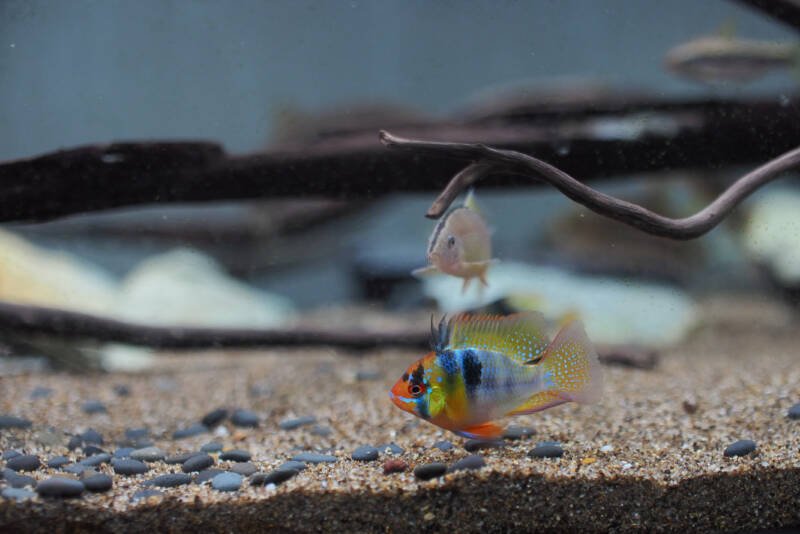
- Difficulty: Easy
- Temperament: Peaceful
- Diet: Omnivore
- Tank Size: 20 gal (76 l)
This South American cichlid is brightly colored in orange, yellow, blue, and black with eye-catching fin shapes.
For those aquarists with a smaller tank or not ready to commit to a large one, the German ram is a perfectly small, two to three inches (5 to 7.6 cm) in length.

They are also peaceful, hardy, and easy to care for, which makes them great for aquarists new to keeping cichlids.
This is a species that must have live plants in its environment, as it will spend a significant amount of time among the vegetation. Bare tanks will elevate stress levels.
These fish live from three to four years, which is on the shorter end of cichlid lifespans.
6. Lemon Lab Cichlid (Labidochromis caeruleus)
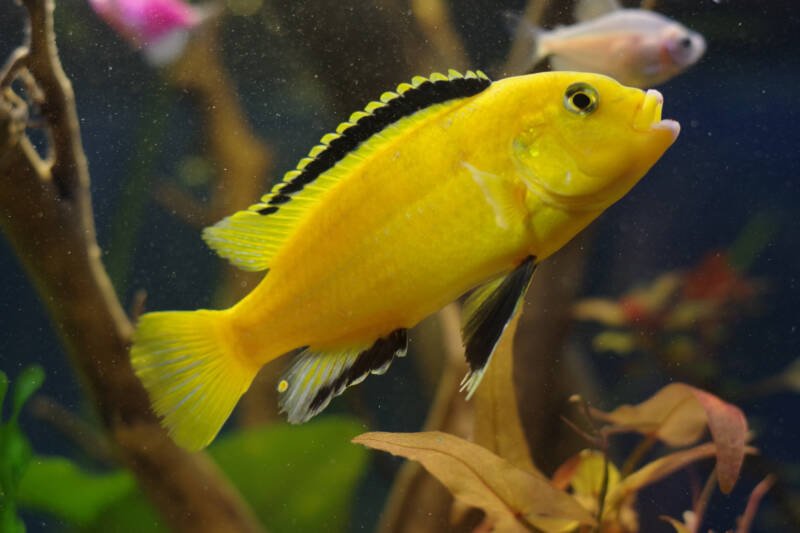
- Difficulty: Easy
- Temperament: Semi-aggressive
- Diet: Omnivore
- Tank Size: 30 gal (114 l)
The lemon lab cichlid is a bright pop of yellow in your tank. This gorgeous color is topped off with contrasting black stripes on the dorsal and ventral fins.
You will not need to go overboard on tank size for this four-inch (10 cm) fish, just keep in mind that they are active swimmers.
This fish favors a carnivorous diet in the wild but in captivity will accept a variety of foods. The addition of vitamin supplements can help to keep their color bright.
They are suitable for a well-planned community tank but are mildly territorial. The safest bet is to keep a higher ratio of females to males to reduce aggression.
7. Goldfish (Carassius auratus)

- Difficulty: Easy
- Temperament: Peaceful
- Diet: Omnivore
- Tank Size: 30 gal (114 l) [varies depending on age and species]
Hardy, popular, and available in such a range of colors, shapes, sizes, and fin types, it is no wonder that the ubiquitous goldfish is the choice of both beginner and advanced aquarists alike.
It takes a quick search to uncover the gorgeous variations, such as Shubunkin, oranda, black moor, ryukin, and comet.
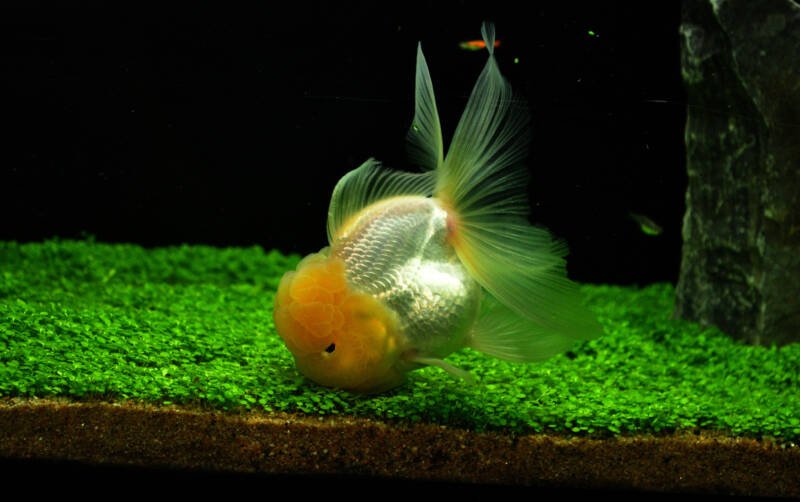
Goldfish are a long-lived fish and, depending on the species you choose, can grow quite large, anywhere from six to 12 inches (15 to 30 cm). Consider the adult size when selecting your tank.
They tolerate an impressive range of water temperatures and can even be kept in outdoor ponds. Plan on regular water maintenance and a sturdy filtration system.
8. Emperor Tetra (Nematobrycon palmeri)
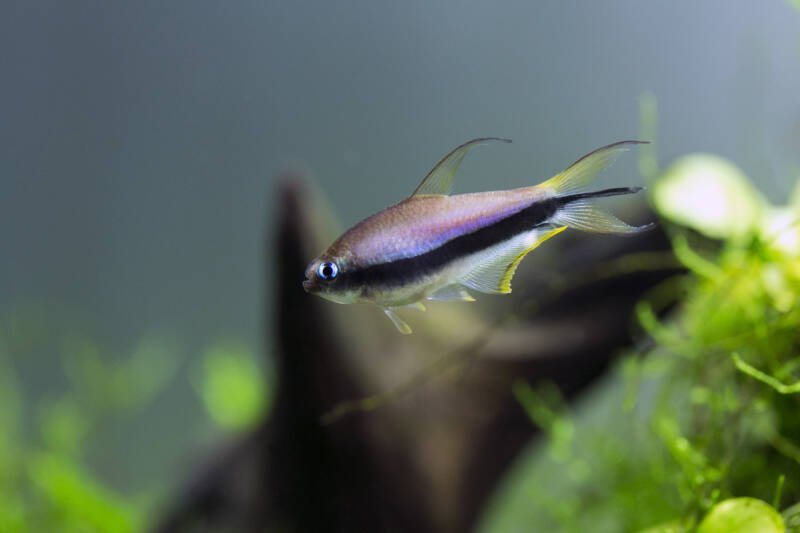
- Difficulty: Easy
- Temperament: Peaceful
- Diet: Omnivore
- Tank Size: 10 gal (38 l)
The emperor tetra combines the joy of a peaceful personality with easy-care suitable for a beginner.
While they are not the most vividly colored fish, their charm lies in their different colored eyes (green for females, blue for males) and their uniquely shaped tails.
They stay a manageable two inches (5 cm) in length. Although they are not schooling fish, they prefer the company of their own kind, so consider a group of around five or six.
These omnivores are not difficult to feed and integrate well into a community tank, where they stick to the middle and top levels.
You may see hierarchical aggression among the males, but it typically resolves with no injuries.
9. Peacock Cichlid (Aulonocara genus)
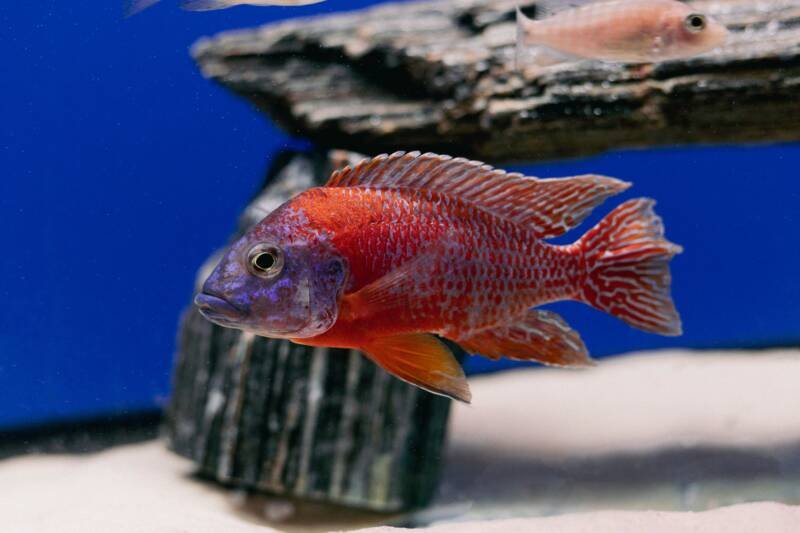
- Difficulty: Easy
- Temperament: Semi-aggressive
- Diet: Omnivore
- Tank Size: 55 gal (208 l)
With a name like “peacock cichlid,” you expect vibrant coloration, and with this fish, you get it!
This Lake Malawi native spends its time near the substrate, where it is highly active in its quest for food.
These fish are a manageable size, with males reaching six inches in length (15 cm) and females four (10 cm).
Suitable for both beginning and experienced aquarists, the peacock cichlid is an undemanding fish. They are enthusiastic swimmers, so if you can go with a larger tank, they will appreciate the space.
They are agreeable in a community setting but can display territorial behavior. Keep more females than males, and do not pair this active hunter with small fish.
10. Fancy Guppy (Poecilia reticulata)

- Difficulty: Easy
- Temperament: Peaceful
- Diet: Omnivore
- Tank Size: 5 gal (19 l)
“Fancy” guppies are correctly known as fantail guppies (not as exciting).
The caudal fin dwarfs the remainder of the body, spreading out in an elegant fan – which is also sort of fancy. They come in every color under the sun, often marked in striking patterns.
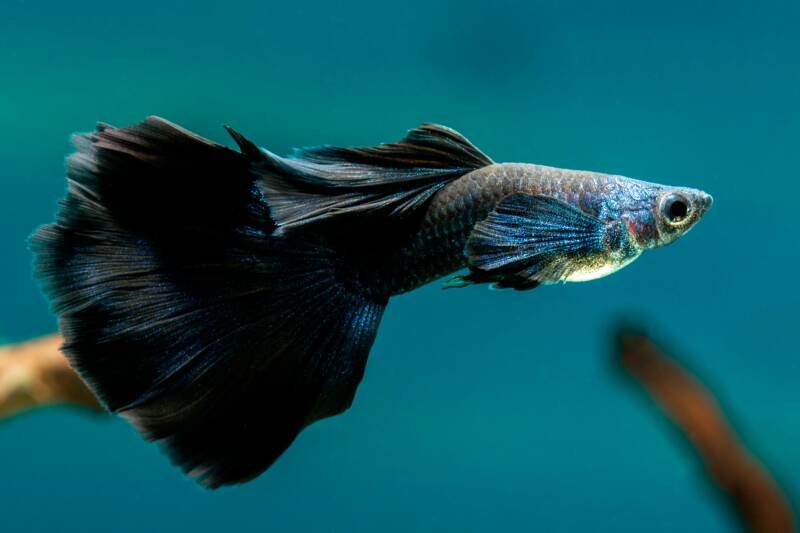
Guppies don’t get much bigger than 2.5 inches (6.4 cm). They prefer to hang out in schools, but you don’t need to go overboard with the numbers – three is fine.
If you don’t want to manage baby guppies, stick to just males in the group (they’re brighter in color, anyway).
If you want a fish with personality, guppies fit the bill nicely. They swim toward anyone who approaches the tank. True, they’re looking for handouts (they’re famous for their voracious appetites), but it’s nice to feel appreciated, right?
11. Glowlight Danio (Danio choprae)
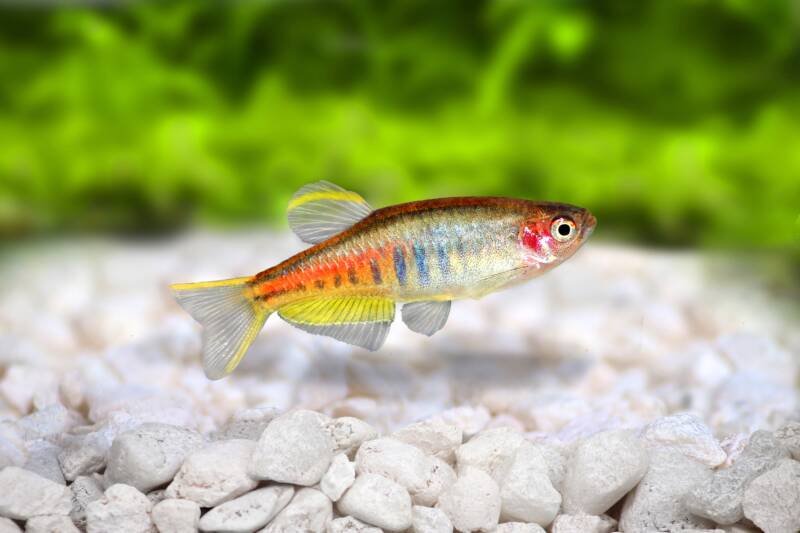
- Difficulty: Easy
- Temperament: Peaceful
- Diet: Omnivore
- Tank Size: 20 gal (76 l)
Glowlight danios broke onto the aquarium scene recently. They sport patterns of green, gold, red, and turquoise that complement any tank.
However, the fact that they’re still emerging as a colorful freshwater fish means they can be hard to find and expensive.
The species got its first description in 1928, but it didn’t make its way to aquariums until 2003! They’re only found in the Irrawaddy River of Myanmar, which is why the costs are so high.
Captive-breeding projects are underway, but the process is slow.
This little fish likes to swim in schools. You COULD get away with ten, but your glowlights would prefer twenty! (Of course – it’s not like they’re difficult to obtain or anything)
Good thing they’re peaceful by nature and get along with like-minded tank mates, such as tetras.
12. Zebra Danio (Danio rerio)

- Difficulty: Easy
- Temperament: Peaceful
- Diet: Omnivore
- Tank Size: 10 gal (38 l)
Zebra danios feature those iconic black horizontal stripes on a variety of colors. You can find zebrafish (the other common name) in turquoise, gold, silver, white, purple, and green.

No matter which you choose, you’ll delight in the colorful addition.
If you want the best color from your zebra danios, make sure you keep them in as large a group as possible.
They need a minimum school of eight to feel secure. If they end up stressed or nervous, they won’t display the full brightness of their colors.
Otherwise, zebrafish make an aquarist’s life easy. They don’t demand anything dramatic in their care.
They tolerate tank mates of a similar size and peaceful nature. And they’re not picky in their diet. What more could you ask for from a colorful freshwater fish?
13. Brilliant Rummy Nose Tetra (Hemigrammus bleheri)
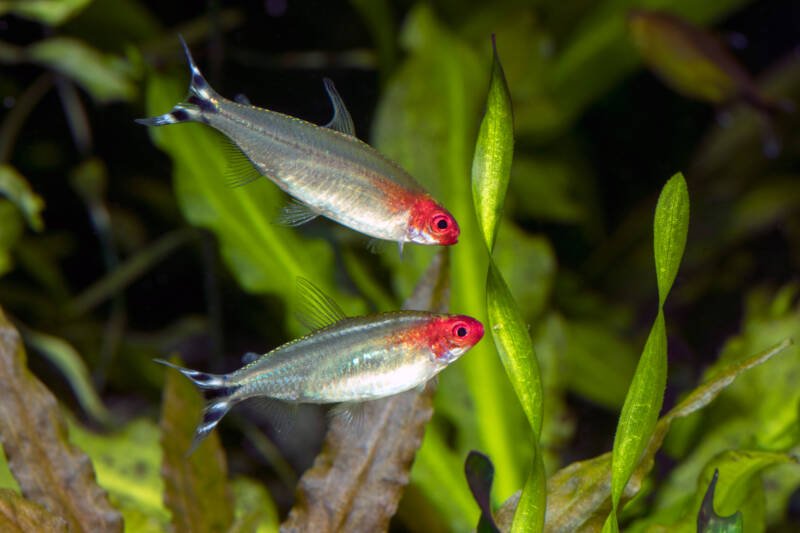
- Difficulty: Moderate
- Temperament: Peaceful
- Diet: Omnivore
- Tank Size: 20 gal (76 l)
There are three species that carry the name “rummy nose tetra;” however, the “brilliant” one (Hemigrammus bleheri) boasts the brightest colors.
These fish have endearing personalities and love to curiously explore their environment.
Their energetic nature necessitates a larger tank than their two-inch (5 cm) size would suggest, allowing a group of 10 plenty of swimming space.
Rummy nose tetras are highly sensitive to shifts in water parameters and need well-maintained water to show their bright red colors. These fish are best suited for aquarists with experience in water testing.
They can be difficult to breed in captivity, which can be a blessing if you do not wish to have fry in your tank.
14. Jack Dempsey (Cichlasoma octofasciatum)
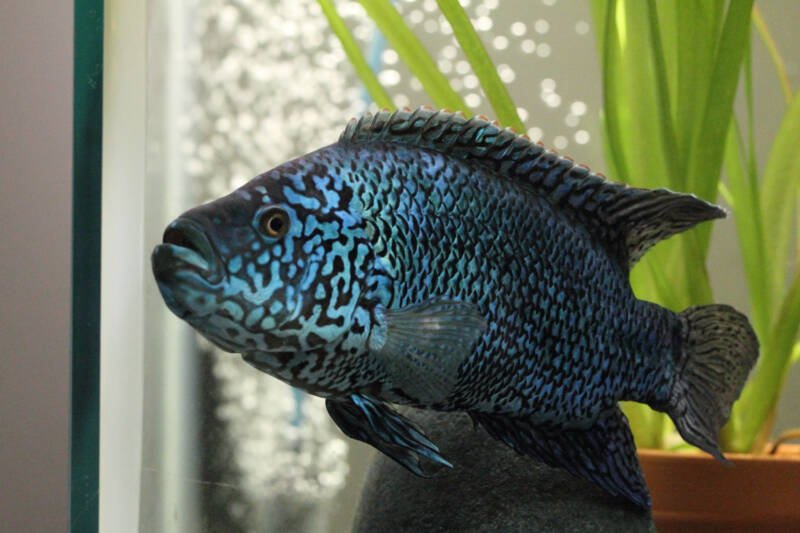
- Difficulty: Difficult
- Temperament: Aggressive
- Diet: Carnivore
- Tank Size: 55 gal (208 l)
The Jack Dempsey lives up to its name with a sturdy, strong body and a feisty temper to match.
They come in a variety of color hues, with the most vivid being the electric blue Jack Dempsey’s shimmering blue scales and elongated fins.
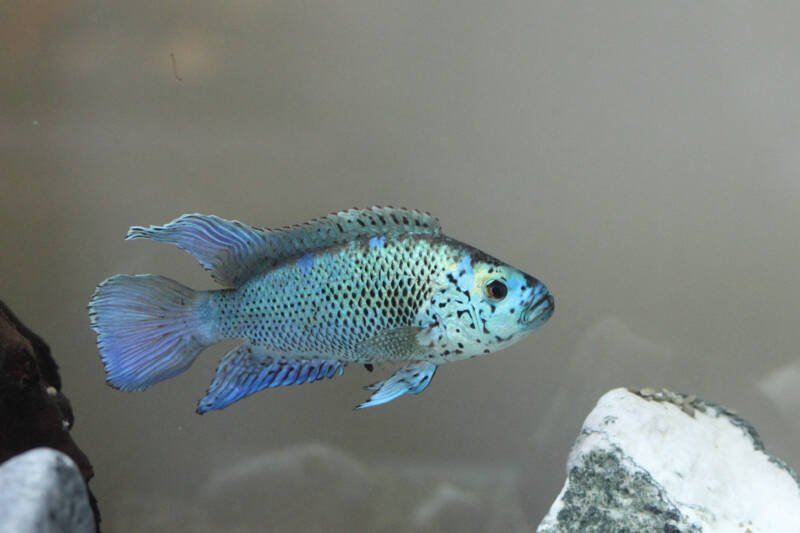
Adult Jack Dempseys reach up to 15 inches (38 cm) in length (electric blues are slightly smaller at eight inches or 20 cm).
They are aggressive and territorial in nature, so a large, well-planned tank is a necessity. These are also incredibly messy fish that need a powerful filter to keep the tank clean.
Carnivorous Dempseys need a variety of meaty foods in their diet and hang around the middle to lower levels of the tank.
15. Blue Frontosa (Cyphotilapia gibberosa)
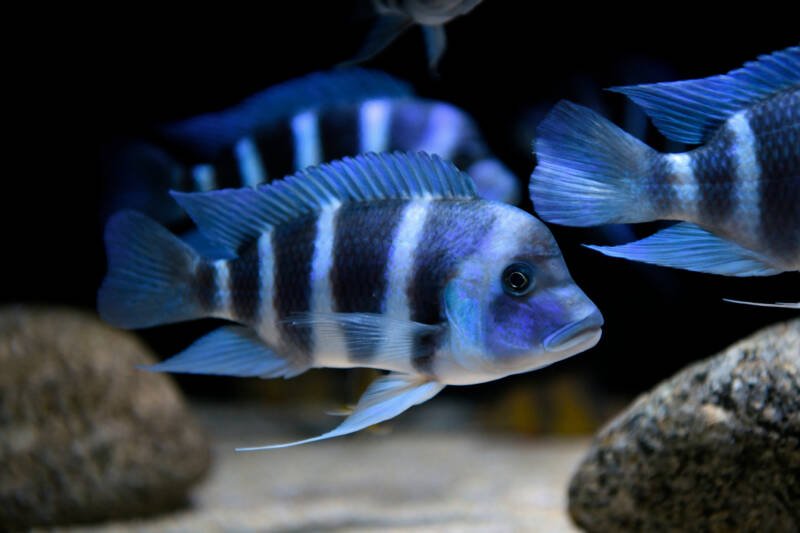
- Difficulty: Moderate
- Temperament: Moderately peaceful
- Diet: Omnivore
- Tank Size: 180 gal (681 l)
The blue frontosa is another incredible cichlid from Africa’s Lake Tanganyika.
Its vibrant blue color develops as it matures, and its bold black stripes and large nuchal hump easily make it the centerpiece of any aquarium.
Males are mildly territorial, especially when spawning. They do not lay claim to a specific cave structure but do squabble for hierarchical dominance, so plan to include several structures to shelter sub-dominant males.
Blue frontosas reach between eight to 10 inches (20 to 25 cm) in size. Given the recommended group size of five to 10 of these highly social fish, a large tank is a must.
Pair these fish with large fish from the same natural habitat.
16. Flowerhorn Cichlid (hybrid)
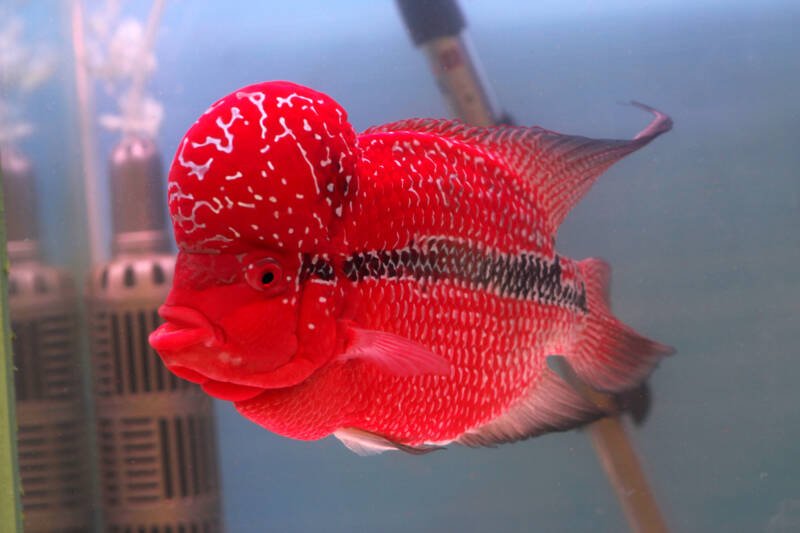
- Difficulty: Moderate
- Temperament: Aggressive
- Diet: Omnivore
- Tank Size: 70 gal (265 l)
The flowerhorn cichlid is another fish with a sizable nuchal hump in addition to chubby jowls and elongated fins.
Bred from the combination of red devil and blood parrot cichlids, this fish is a stunning, bright red color.
They have a long lifespan of 10 to 12 years and need a large tank to house their 12-to-16-inch (31 to 41 cm) bodies.
These active swimmers are highly aggressive and territorial. They do not need much in the way of decoration in their tanks, but softer substrate and some plants will provide enrichment.
Flowerhorns have delightful personalities and will visibly interact with their owners. They can be kept as a single specimen or in small groups depending on individual temperament.
17. Kribensis (Pelvicachromis pulcher)
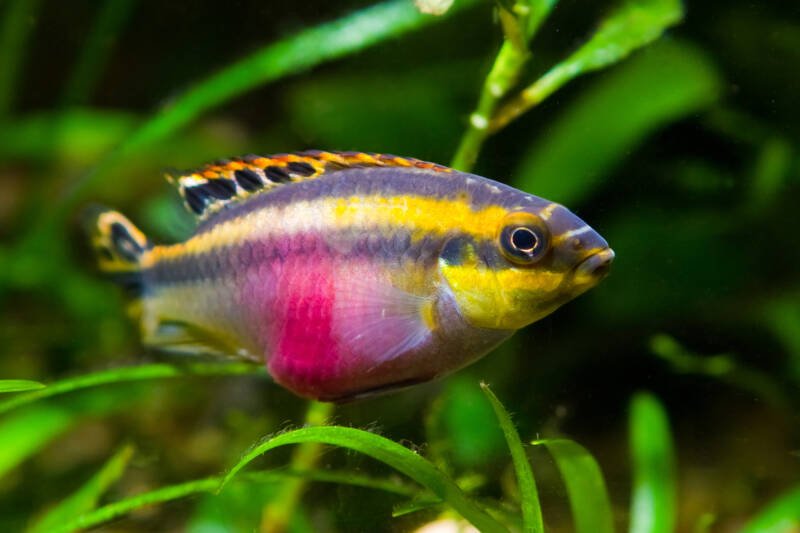
- Difficulty: Easy
- Temperament: Peaceful
- Diet: Omnivore
- Tank Size: 20 gal (76 l)
Kribensis is wonderfully easy to care for, has high activity levels, and can adapt to a wide range of water conditions.
Females boast a bright red spot on their belly, and the males have elongated, sweeping fins tipped with red, gold, and sometimes, black spots.
They may not be brightly colored in the store, but when you get them home and put them in top-quality water conditions, their color will intensify.
Males reach five inches (13 cm) fully grown while females stay closer to four (10 cm).
Caves are a must in any tank housing those dwarf cichlids. Make sure there is one for every krib and avoid housing them with other cave-dwelling species.
18. Tropheus Kasanga Rainbow (Tropheus kasanga)
- Difficulty: Moderate
- Temperament: Semi-aggressive
- Diet: Herbivore
- Tank Size: 55 gal (208 l)
The tropheus kasanga rainbow, true to its name, sports a gradient rainbow of colors on its body with attractive, spiny fins. Their dorsal fin is typically red but can sometimes exhibit blue as well.
Males tend to be more colorful than females. Proper lighting in the tank will truly make this fish’s colors pop!
This native to Africa’s Lake Tanganyika can occasionally be aggressive toward their own kind. They should be kept in groups of at least 12 with more females than males to minimize aggression.
They reach around five inches (13 cm) in length and need a sizable tank.
Tropheus are susceptible to bloat, so make sure they receive an appropriate variety of vegetable-based foods.
19. Bettas (Betta splendens)
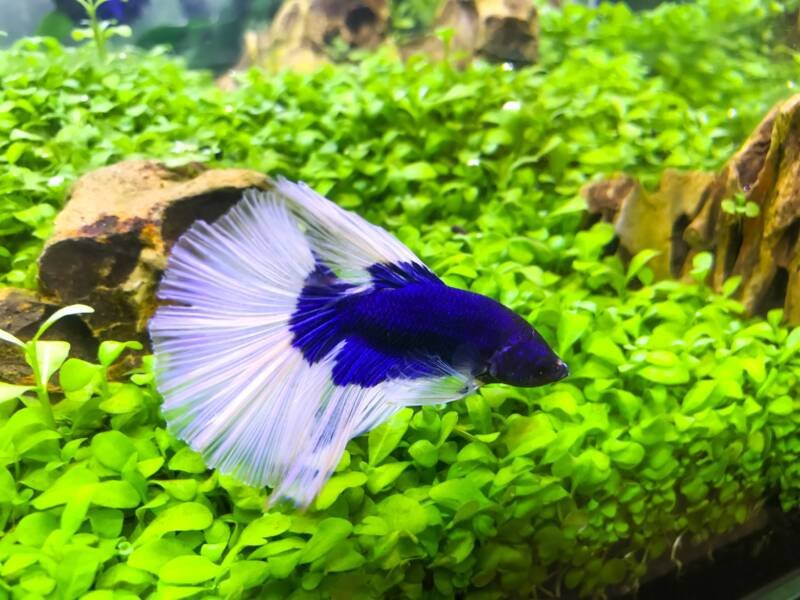
- Difficulty: Moderate
- Temperament: Semi-aggressive
- Diet: Carnivore
- Tank Size: 5 gal (20 l)
Blue, red, black, and yellow as well as metallic, marble, opaque, and even clear – the betta fish can be any one or a combination of these.
In addition to their lovely color, these fish often have dramatic, flowing fins that are eye-catching when the fish are swimming or flaring them.
These fish possess a labyrinth organ, and access to the water surface is necessary. They are active and tend to overeat if given too much food.
While females can live in a group without conflict, males should not be housed together as they will fight for dominance.
They stay around three inches (7.6 cm) in length and reach this size in as little as seven months.
20. Discus (Symphysodon spp.)

- Difficulty: Difficult
- Temperament: Peaceful
- Diet: Omnivore
- Tank Size: 75 gal (284 l)
This fish’s unique shape, range of colors, and variety of patterns make it a prized freshwater specimen.
Discus look amazing in a large school and need a minimum of six fish to be comfortable. They may show aggression among themselves until they establish a hierarchy.
With their adult length of seven to nine inches (18 to 23 cm), you will need a large tank. Choose one that is tall (at least 18 inches) to give these fish room to swim.
Discus require warm water temperatures and need pristine conditions, making regular tank maintenance a must.
These are not the cheapest fish on the market, so take your time and properly cycle your tank before bringing these fish home.
21. White-blotched River Stingray (Potamotrygon leopoldi)
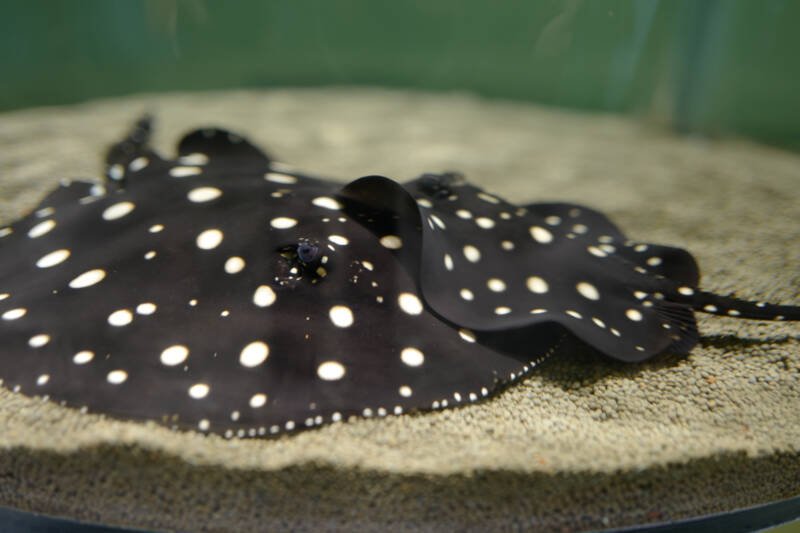
- Difficulty: Difficult
- Temperament: Peaceful
- Diet: Carnivore
- Tank Size: 500 gal (1900 l)
For serious “WOW” appeal, how about adding a stingray to your tank? This freshwater species is a dark color all over with prominent white dots on its dorsal side.
They are 16 inches (40 cm) at their widest point and must be in constant motion to survive. Therefore, they need a large tank with significant swimming space along the bottom.
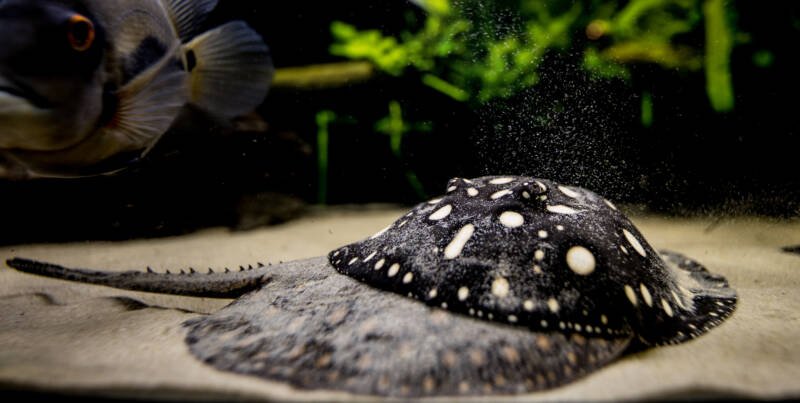
Although freshwater stingrays are carnivores, this species is shy and should not live with other aggressive species. However, they can pair with larger schooling fish that occupy the upper levels.
Their skin is sensitive to contaminants and the chemicals present in commercial fish medicines, so take care when treating sick fish.
22. Neons and Cardinals (Paracheirodon innesi and axelrodi)
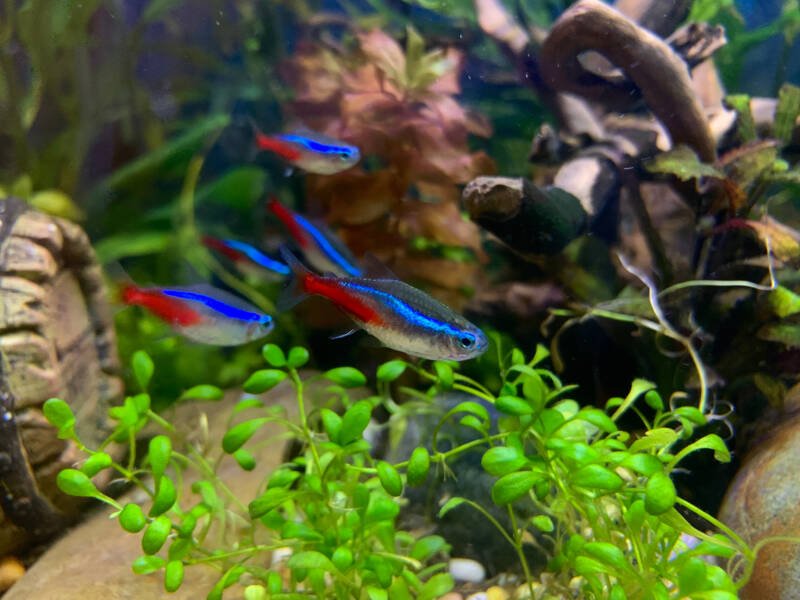
- Difficulty: Easy
- Temperament: Peaceful
- Diet: Omnivore
- Tank Size: 30 gal (114 l)
Tiny, lively, and boasting bright colors, neons and cardinal tetras are by far the most easily recognized aquarium fish. Their ease of care makes them perfect for beginners.
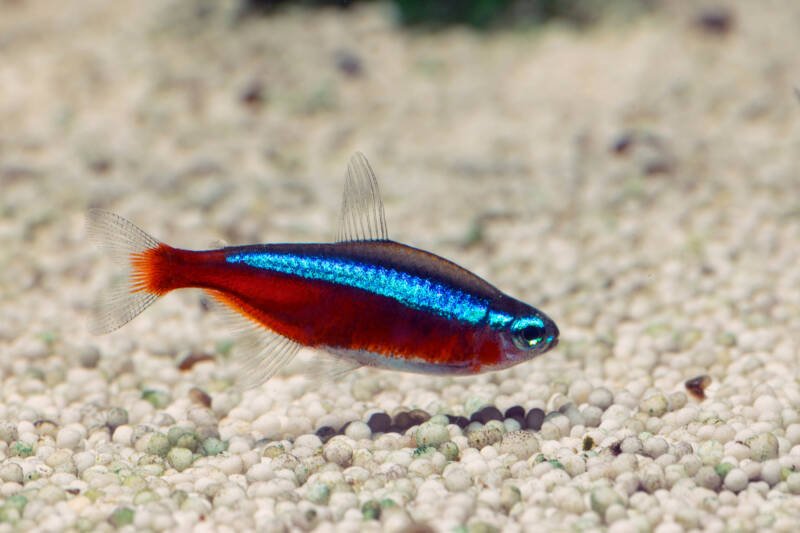
They look so similar that one species is often mistaken for the other. Each has a vivid, horizontal turquoise line with a red line below.
In the neon tetra, the red line begins midway along the body, whereas the line extends from eye to tail on the cardinal.
Whichever you choose, these schooling fish should be kept in groups of at least six, although larger groups are even better.
The neon is slightly hardier and more tolerant of varying water conditions than is the cardinal.
23. Gold Barbs (Puntius semifasciolatus)
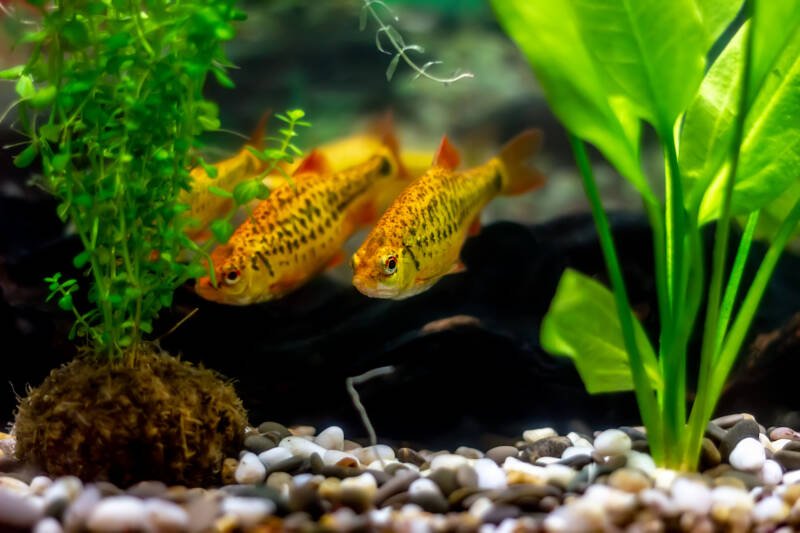
- Difficulty: Easy
- Temperament: Peaceful
- Diet: Omnivore
- Tank Size: 20 gal (76 l)
Get yourself a school of gold barbs for a pleasing display. Naturally colored green in the wild, their shimmering gold color comes as the result of selective breeding.
Undemanding in tank setup and not picky with food, care for these little guys is as easy as it gets. Provide them with plants and hiding spaces to be comfortable.

They reach a maximum length of three inches (7.6 cm), so you will not need a large tank. Keep them in a group of five to six fish.
Gold barbs have a wonderfully peaceful nature that makes them perfect for community tanks. They shoal in the middle to lower levels but will travel to the top for food.
24. Dwarf Gourami (Trichogaster Ialius)
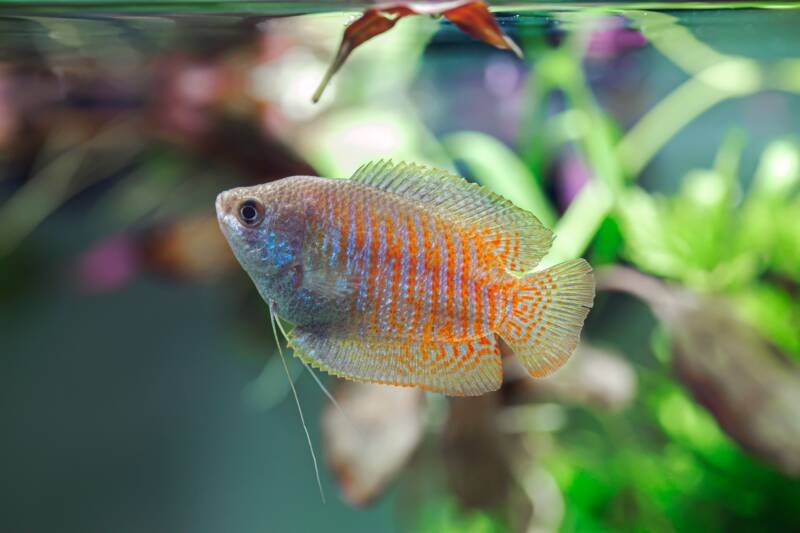
- Difficulty: Easy
- Temperament: Peaceful
- Diet: Omnivore
- Tank Size: 10 gal (38 l)
Generations of tank breeding have resulted in a wide variety of colors for this stunning fish, including powder blue, flame orange, honey-yellow, and neon blue.
While their gentle nature allows them to pair well with other species, avoid those that are overly active as they will stress your gourami. Consider bottom-dwelling fish as excellent tank mates for them.
At an adult length of 3.5 to 4.5 inches (9 to 11 cm), the dwarf gourami is a manageable size. They tolerate various water conditions but are sensitive to spikes in ammonia.
Their unique nest-building habits and parental care activities make breeding these fish an interesting hobby.
25. Bronze Corydoras (Corydoras aeneus)
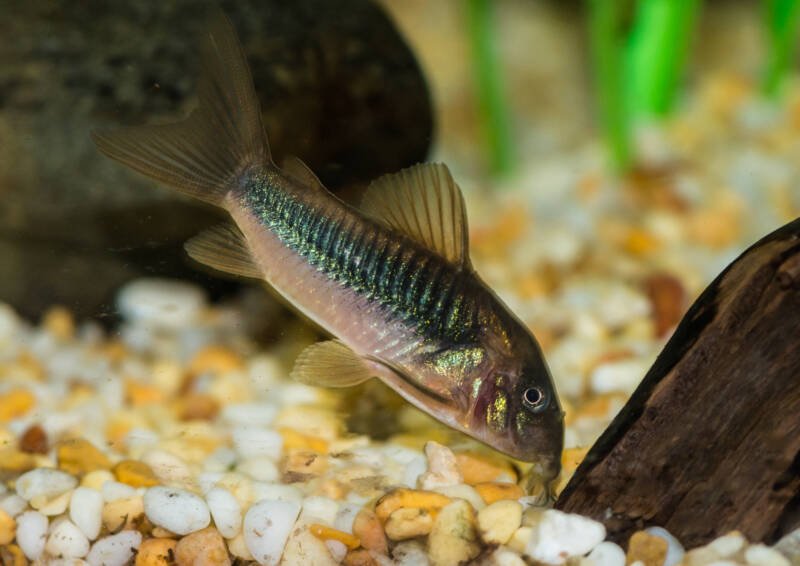
- Difficulty: Easy
- Temperament: Peaceful
- Diet: Omnivore
- Tank Size: 30 gal (114 l)
Imagine a metallic glint along the bottom of your tank. The bronze corydoras provides this unique look with colors ranging from copper to olive and even pink or cream.
They are a schooling species that need a group of six to be comfortable.
At an adult length of three inches (7.6 cm), this size group does not require a massive tank, but you still want to give them some space.
They will happily scavenge for food but should be spot fed as well to ensure they are getting complete nutrients. Provide a soft substrate over which they can roam.
With proper care, these long-lived fish can grace your tank for up to 10 years.
26. Killifish (1270 different species)
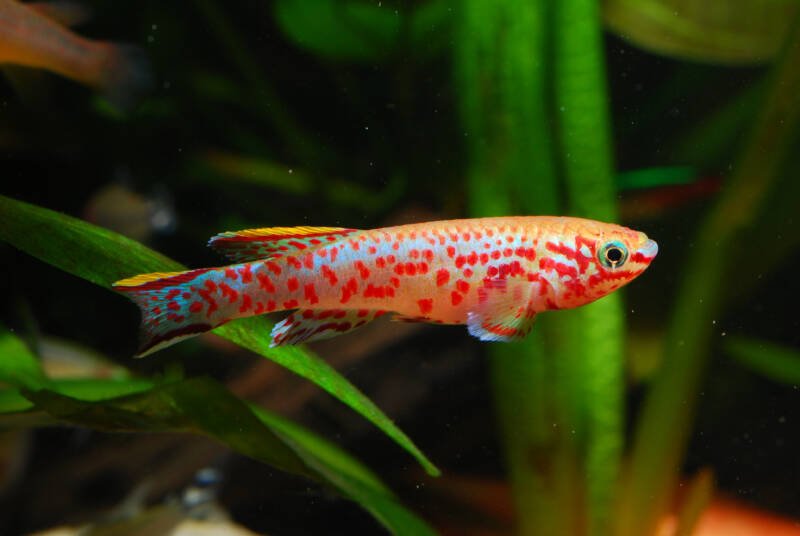
- Difficulty: Easy-Moderate (depending on species)
- Temperament: Aggressive
- Diet: Omnivore
- Tank Size: 20 gal (76 l) or more
With over 1200 species to choose from, you’re spoiled for choice in colors and patterns when it comes to killifish.
These remarkable fish come from Africa, Asia, Europe, North America, and South America, and each region provides unique adaptations.
Killifish are active swimmers, and they’re known for jumping.
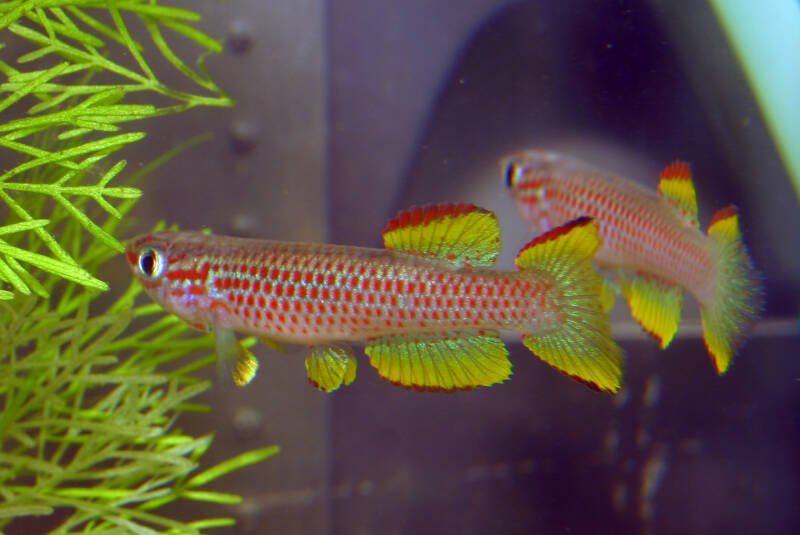
While some species have an incredible ability to survive out of the water (with moist conditions), you’re better off making sure the top of the tank gets secured with a lid.
Each killifish species is unique. Make sure you research your intended fish carefully before adding it to a community tank.
Some are more aggressive than others. Males are known to get territorial with each other, so stick to just one in your schools.
27. Pencilfish (Nannostomus mortenthaleri)
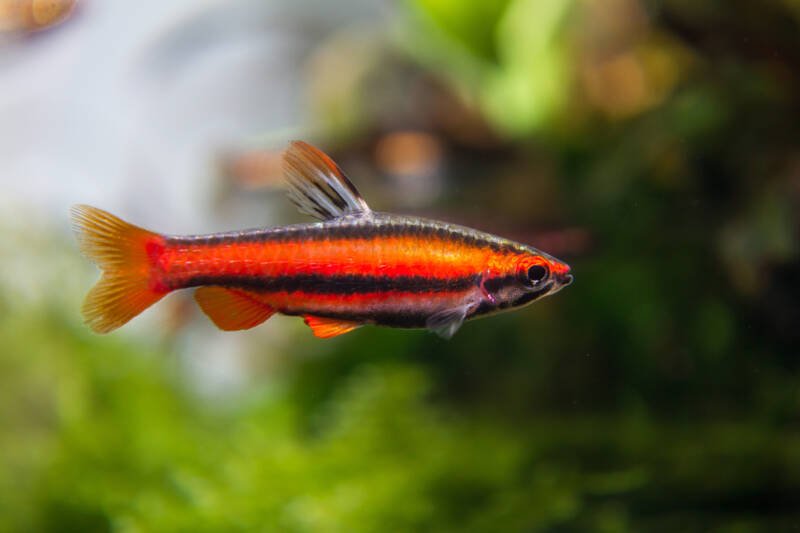
- Difficulty: Moderate
- Temperament: Peaceful
- Diet: Omnivore
- Tank Size: 15 gal (57 l)
If you wish to add colorful motion to the middle and top areas of your tank, the pencil fish will do the job. There are numerous Nannostomus species, and one of the most striking is the mortenthaleri, or red coral pencilfish.
This Peruvian native needs a well-planted tank with slow-moving, highly acidic, warm water.
They shoal well and are best for a single species or larger community tank where they can have adequate swimming space.
These fish are a tiny 1.25 inches (3 cm) as adults.
Keep a large group of these fish – around 12 or so. This size will spread out potential aggression among males while bringing out their most vibrant colors.
28. Electric Blue Acara (Andinoacara pulcher)
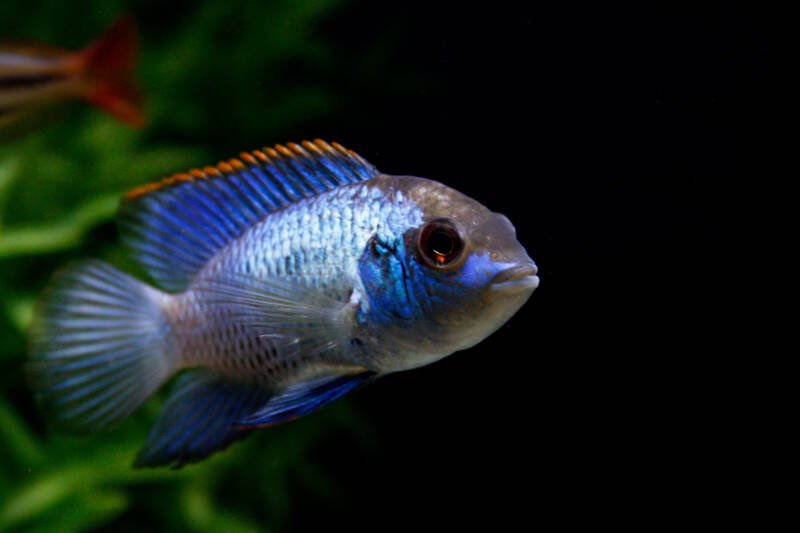
- Difficulty: Easy
- Temperament: Peaceful
- Diet: Omnivore
- Tank Size: 30 gal (114 l) for a single fish
A peaceful, stunningly colored cichlid? You got it! The electric blue acara is a Central and South American freshwater cichlid with bright blue scales and fins tipped with orange.
Theses active fish reach anywhere from six to seven inches (15 to 18 cm) fully grown and require a 30-gallon tank (114 l) for a single fish. For any additional fish, add 15 gallons.
If you keep multiple acaras, make sure the school number is divisible by two. These omnivores need a varied diet that includes live food to be healthy and reach their eight-to-10-year lifespan.
Any tank mates you pair with the blue acara should match well in size as smaller or larger species may trigger aggression.
29. Cherry Barb (Puntius titteya)

- Difficulty: Easy
- Temperament: Peaceful
- Diet: Omnivore
- Tank Size: 20 gal (76 l)
Contrary to popular belief, cherry barbs don’t have that vibrant red color all the time. Most of the time, cherries come in silver or white.
It’s only during the breeding season that males turn the bright red color for which they earned their name.
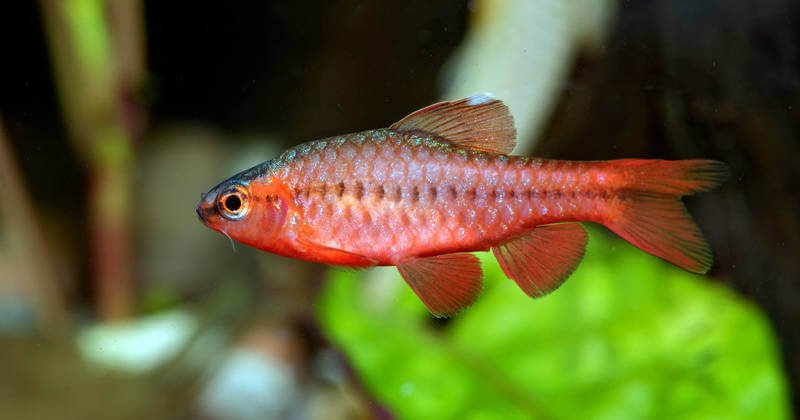
Cherry barbs need schools to avoid skittish, bolting behavior. Even in a group, make sure you provide plenty of plants so everyone feels comfortable.
Don’t overcrowd the tank, though. You want a nice balance between the swimming room and places to hide.
While undemanding in their care, even beginning aquarists should think twice about bringing home cherry barbs!
In the wild, they’re listed as vulnerable due to overharvesting! So while they’re colorful, maybe consider a different option for your tank.
30. Clown Loach (Chromobotia macracantha)
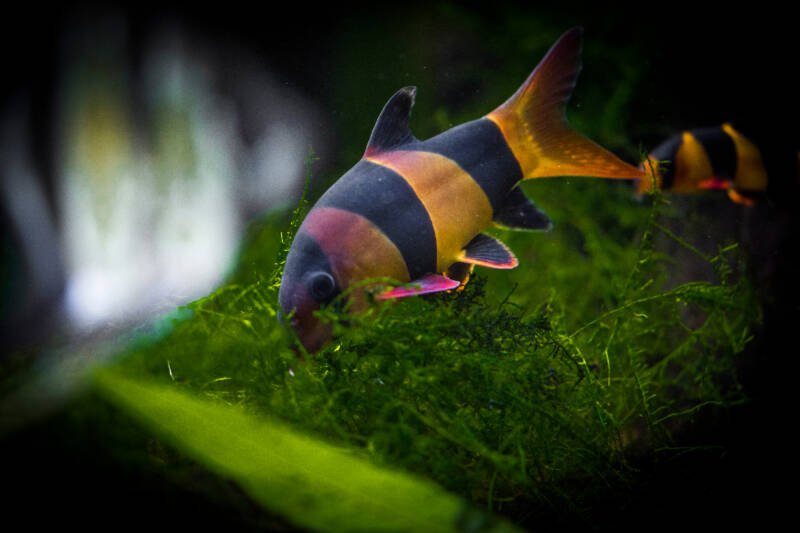
- Difficulty: Moderate
- Temperament: Peaceful
- Diet: Omnivore
- Tank Size: 100 gal (379 l)
Clown loaches sport vivid bands of orange and black. Aquarists often skip them, but the alternating patterns make a colorful addition to any community aquarium.
And unlike most loaches, clown loaches don’t have a bullying problem.
That said, most beginning aquarists fail to realize how large their clowns will get. These loaches top out around 12 inches (30 cm) as adults!
You also need to keep them in schools of at least six to prevent stress. That means a LARGE aquarium!
Clown loaches have LONG lifespans. Some live up to 25 years with proper care!
So if you decide to bring clowns into your aquarium, make sure you prepare for the investment. While other colorful freshwater fish come and go, your loaches are here to stay…
31. Boeseman’s Rainbow (Melanotaenia boesemani)
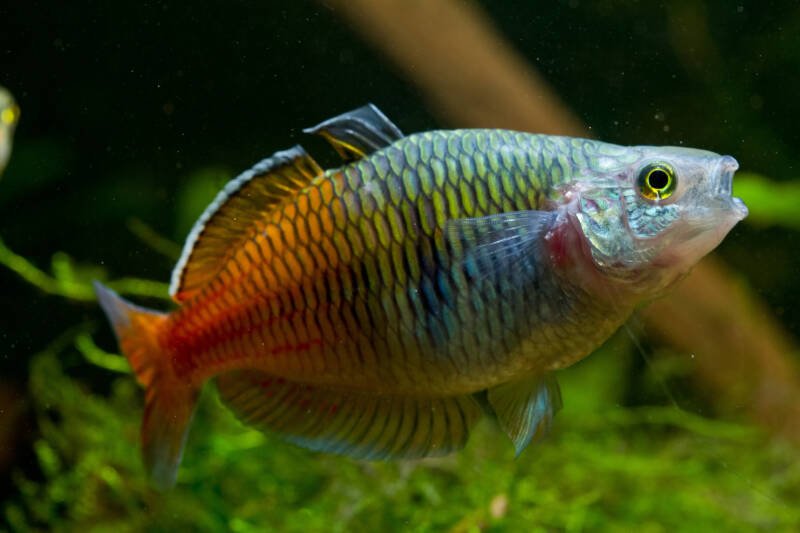
- Difficulty: Easy
- Temperament: Peaceful
- Diet: Omnivore
- Tank Size: 40 gal (150 l)
Boeseman’s rainbows split their colors between a silvery-blue at the front and a flashy orange at the tail. The pattern’s unique among the rainbowfish.
This particular species comes from New Guinea, and they swim in heavily planted areas where the color shows nicely.
Rainbows get to an adult length of around 4 inches (10 cm). You also need to keep them in schools of eight at least, so plan tank size accordingly.
Unhappily, they’re not the cheapest freshwater fish out there, so save your pennies if you have your heart set on this colorful fish.
Boeseman’s rainbows have NARROW tolerances for changes in water quality.
If water conditions slip, you’ll see your fish drift to the bottom. They’ll also keep their fins clamped close to their sides. This is a warning to check your water fast!
32. Platy (Xiphophorus maculatus)
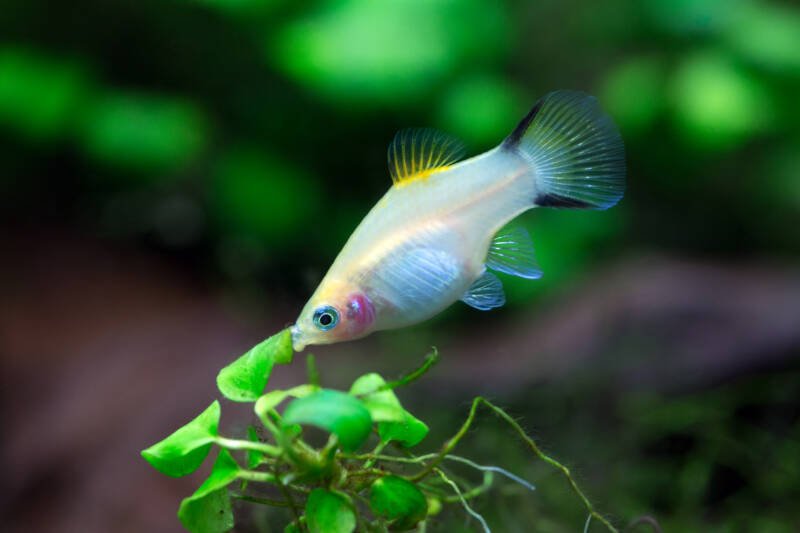
- Difficulty: Easy
- Temperament: Peaceful
- Diet: Omnivore with a preference for plants
- Tank Size: 10 gal (38 l)
Platies come in many color options. The red wagtail platy tops a lot of aquarists’ lists, but you can find a variety of colors to suit your aquarium needs (even a rainbow option).
They’re flattened fish with fan-shaped tails. Relatively small fish, they don’t get beyond 2 inchers (5 cm).
They prefer to swim in schools, and they do well in community tanks.
You can pair them with other peaceful fish of the same size. Consider mollies or guppies, if you want complementary patterns.
While platies ARE omnivores, they lean a little closer to the herbivore side.
You can include brine shrimp on the menu, but make sure you go heavier on plant-based foods. And keep a close eye on the plants in your tank.
33. Royal Blue Danio (Danio kerri)
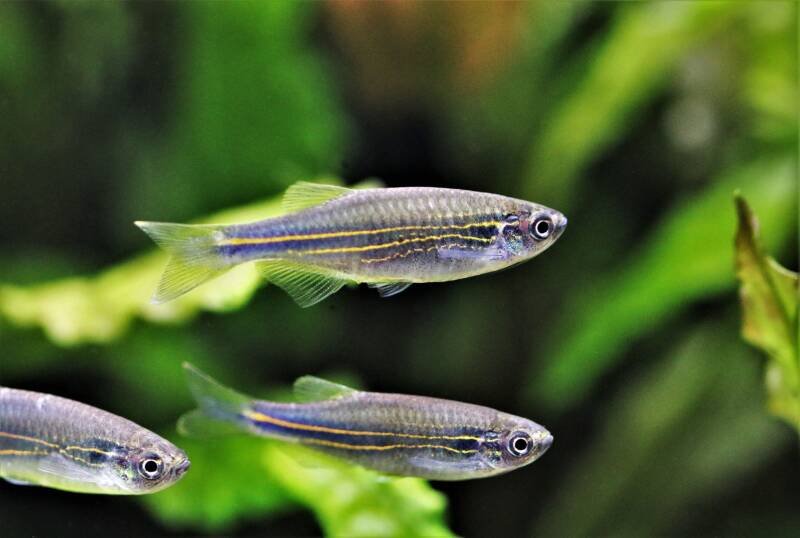
- Difficulty: Easy
- Temperament: Peaceful
- Diet: Omnivore
- Tank Size: 10 gal (39 l)
No one claimed scientists were the most creative people in the world. So, yes, the royal blue danio is a vibrant blue color with yellow stripes.
If you use a dark substrate and plenty of plants, the blue shade pops against the background.
Blue danios are schooling fish. You’ll need a minimum of eight to prevent stress in the group, but, in this case, the larger the shoal, the better. (Remember: stress equals paler colors)
They’re active swimmers AND jumpers, so keep the tank lid secure at all times.
The schooling instinct runs strong in royal blue danios. These vibrant little fish interact with other fish of similar size.
You might even notice them shoaling with others in your community tank, especially if your danio school is on the small side.
34. Swordtail (Xiphophorous hellerii)
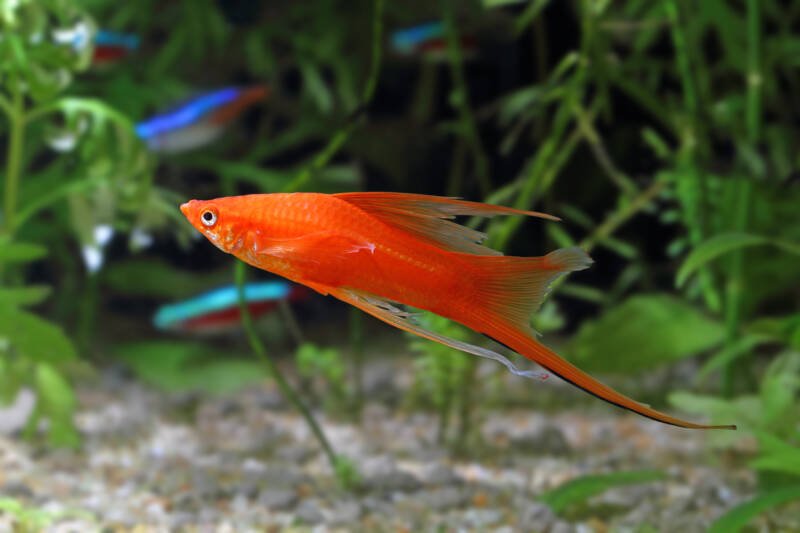
- Difficulty: Easy
- Temperament: Peaceful
- Diet: Omnivore
- Tank Size: 15 gal (57 l)
Swordtails share a common genus with platies. However, their bodies tend to be a little bulkier, and the caudal fin carries a long projection that gives them their name.
As to the color palette, like other livebearers, you have a spectrum to choose from.
In a break from the common shoaling fish, while you still need to keep your swordtails in a group, they don’t bunch together in a school.
This makes them a great addition to a community aquarium, as they disperse in a loose cluster throughout the water column.
Males DO get aggressive with each other, so try to avoid more than one if you go with a smaller tank.
And adults WILL devour their fry. Make sure you keep a magnifying glass on hand to keep an eye out for tiny swordtails if you keep males and females together.
35. Calvus Cichlid (Altolamprologus calvus)
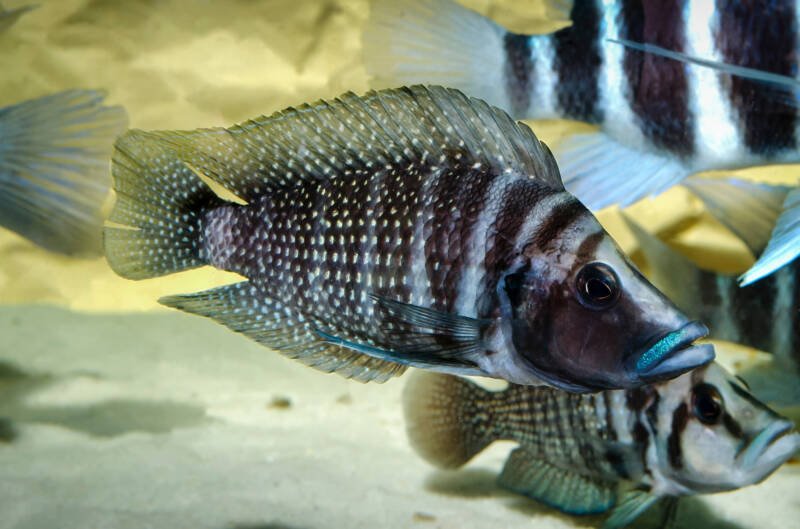
- Difficulty: Moderate
- Temperament: Peaceful
- Diet: Carnivore
- Tank Size: 40 gal (151 l)
The calvus cichlid has the sleek, laterally compressed shape of a predator. Adorned with dark stripes and spots, they have serrated body scales for protection and a scaleless patch on their head.
They are a slow-growing species reaching a length between four and six inches (10 and 15 cm).
Keep this fish in a dimly lit aquarium with piles of rocks forming caves to encourage the most activity.
A little on the shy side, the calvus will coexist with similarly sized fish. Avoid housing it with aggressive species and smaller tank mates.
Sudden shifts in water parameters and chemistry will adversely affect these fish, and they are best kept by aquarists with some experience.
36. Ember Tetra (Hyphessobrycon amandae)
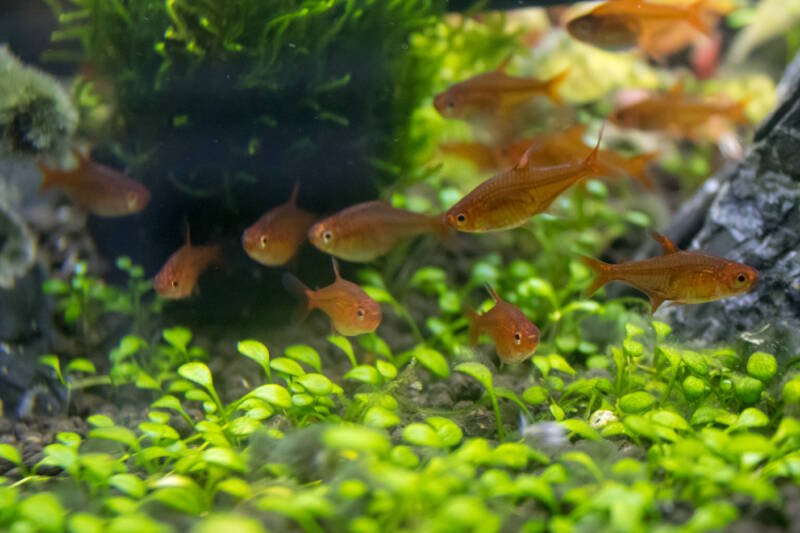
- Difficulty: Easy
- Temperament: Peaceful
- Diet: Omnivore
- Tank Size: 10 gal (38 l)
Glowing with the orange/red of a dying fire, the ember tetra is a beautiful addition to a home aquarium.
Their adult size of less than one inch (2.5 cm) makes them suitable for nano aquariums. A reasonable 10 gallons of water will allow a school of eight fish.
That tank size will also allow the lush plantings your ember tetras need to be comfortable. A barren tank will elevate their stress levels.
These fish are incredibly easy to care for and are perfect for beginning aquarists. Their high activity levels and shoaling behavior make them fun to watch!
They favor the middle levels of the tank. Pair them with small, non-aggressive fish that occupy other levels.
37. Endler’s Livebearer (Poecilia wingei)
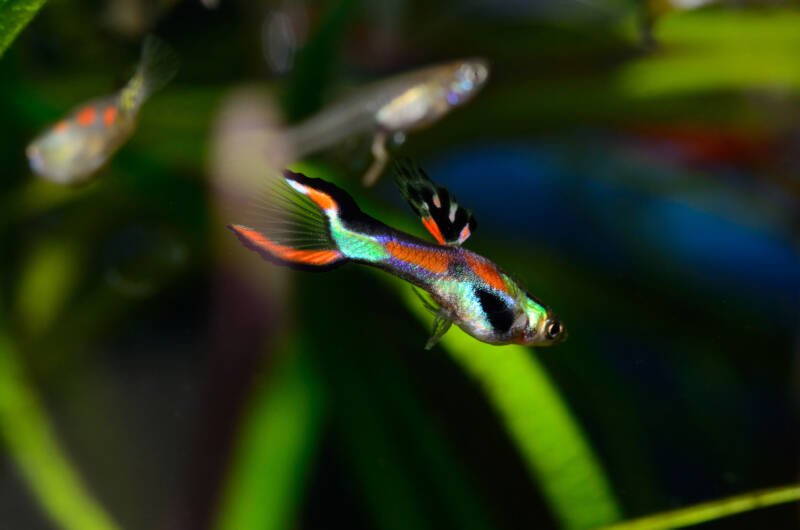
- Difficulty: Easy
- Temperament: Peaceful
- Diet: Omnivore
- Tank Size: 2 gal (7.5 l)
Endler’s livebearers come in as many colors and patterns as you can think of.
One of the most popular is the red flame endler, which sports red, green, and teal shades. You’ll find plenty of colorful options in this species.
Endlers are tiny, not reaching more than 1 inch (2.5cm) at full growth.
They also aren’t interested in schooling (which is why you don’t need a huge tank). You can keep a pair together without a problem, though.
Endler’s livebearers require harder water than most freshwater fish. This makes mixing them into a community aquarium a little tricky.
If you want a colorful nano tank, though, they make a perfect choice. Just keep an eye out for teeny fry if you have a male and female!
38. Celestial Pearl Danio (Celestichthys margaritatus)
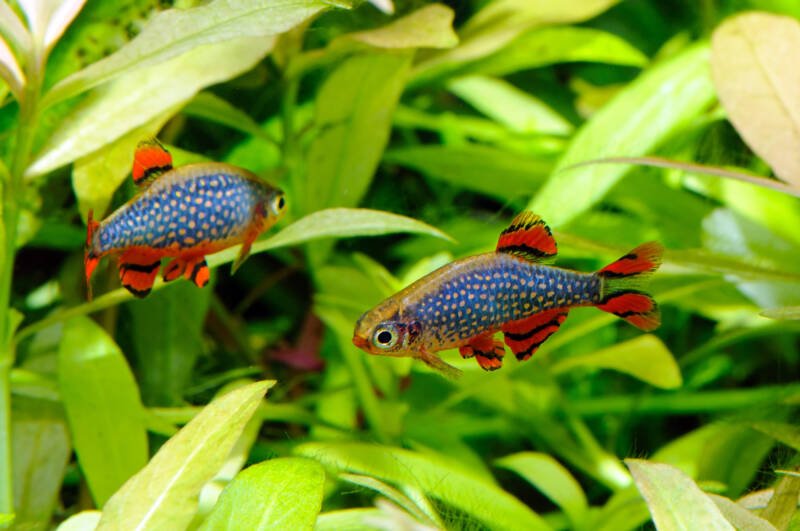
- Difficulty: Easy
- Temperament: Peaceful
- Diet: Omnivore
- Tank Size: 10 gal (38 l)
Celestial pearl danios also come up under the name galaxy rasboras (not confusing at all). They AREN’T rasboras, though, so don’t get confused.
They have deep blue scales with pearl-bright spots (hence their official name).
If you’re interested in keeping a colorful nano aquarium, celestial pearl danios make great options. These tiny fish rarely get larger than one inch (2.5 cm) in length.
However, they prefer to hang out near the bottom, so choose a different small fish for the middle of the water column.
Males have a more vibrant color than females but watch your ratios carefully. Males fight over females, and battles can get brutal.
If you want to maintain peace in the tank, keep more females than males.
Setting Off Freshwater Fish Colors

If the colors and patterns of freshwater fish are what draw your attention, odds are you want those vibrant hues to stand out in the tank.
Take a few careful steps, and you’ll ensure a colorful aquarium that’ll make you the envy of the neighborhood.
Diet
How healthy would you be on the same food day after day? The same applies to your fish. The more varied a diet you provide, the more their natural colors will brighten and pop.
A stocked cabinet of the highest quality foods keeps the hues at their deepest saturation.
Whether you have omnivores, carnivores, or even bottom-dwelling scavengers, change up the diet regularly.
You can always find different options to keep the menu fresh and exciting. Rotate through stock, and make sure to switch between fresh and frozen options.
Decorating a Colorful Tank
Pet and aquarium stores come stocked with colorful decorations. Substrates feature gravels in every shade imaginable.
If you’re not a fan of live plants, you can find plastic options in electric and neon colors.
And decorations span the spectrum. However, such unnatural hues dull the colors of your freshwater fish.
If you want your fish to stand out, skip the neon and opt for natural shades. Stick to browns, blacks, greys, and muted tones. Give your fish’s colors in the spotlight.
Freshwater fish that feel safe develop brighter colors. Make sure you provide plenty of the following:
Dim the Lights

Reef tanks need stronger lights. Corals require a substitute for natural sunlight to produce food and grow.
It’s why you see vibrant marine aquariums. Saltwater tanks with lower light levels cause the corals to “brown out.”
Freshwater fish – and freshwater plants, for that matter – don’t have the same concerns.
So turn the lights down. You’ll see your fishes’ colors intensify. On the flip side, if you keep brighter lights, your fish will appear dull.
Colorful Freshwater Fish Tank Setup
Freshwater fish often play nicely together. You can combine different species and different types without a problem.
You need to consider aggressive tendencies – such as with cichlids or freshwater sharks – which means keeping sizes in mind, but most can share aquarium space.
If your array of rainbow colors has similar water quality needs, the limits are endless.
Do your homework first, though. Some freshwater fish tolerate wider ranges in temperature and pH than others, and you want to make sure you keep everyone in the tank happy.
| Species | Temperature | pH | Hardness | Nitrites | Ammonia | Nitrates |
| Boeseman’s Rainbow | 81-86°F (27-30°C) | 7.0-8.0 | 10-20dH | 0ppm | 0ppm | <40ppm |
| Celestial Pearl Danio | 71-78°F (22-26°C) | 6.5-7.5 | 2-10dH | 0ppm | 0ppm | <20ppm |
| Cherry Barb | 75-80°F (24-27°C) | 7.0-7.8 | 3-20dH | 0ppm | 0ppm | <20ppm |
| Clown Loach | 75-85°F (24-29°C) | 7.4-7.8 | 5-15dH | 0ppm | 0ppm | <25ppm |
| Endler’s Livebearer | 70-84°F (21-29°C) | 7.0-8.0 | 10-20dH | 0ppm | 0ppm | <40ppm |
| Fancy Guppy | 74-82°F (23-28°C) | 7.0-7.8 | 8-12dH | 0ppm | 0ppm | <40ppm |
| Glowlight Danio | 73-79°F (23-26°C) | 6.5-7.0 | 8-12dH | 0ppm | 0ppm | <50ppm |
| Killifish | 68-75°F (20-24°C) | 6.0-7.0 | 7-10dH | 0ppm | 0ppm | <40ppm |
| Platy | 73-77°F (23-25°C) | 7.0-8.0 | 12-18dH | 0ppm | 0ppm | <40ppm |
| Royal Blue Danio | 72-77°F (22-25°C) | 6.5-7.5 | 3-8dH | 0ppm | 0ppm | <50ppm |
| Swordtail | 65-82°F (18-25°C) | 7.0-8.4 | 12-30dH | 0ppm | 0ppm | <40ppm |
| Zebra Danio | 77-82°F (25-28°C) | 6.5-7.2 | 5-25dH | 0ppm | 0ppm | <50ppm |
Rainbow Connection
Whether you prefer cichlids or tetras, catfish, or cyprinids, the color possibilities are endless.
Freshwater fish provide the same level of color and saturation as marine reef tanks. For much less maintenance!
What colorful freshwater fish have you incorporated into your tank?
Do you have particular groups that are your favorites? Share your stories here!